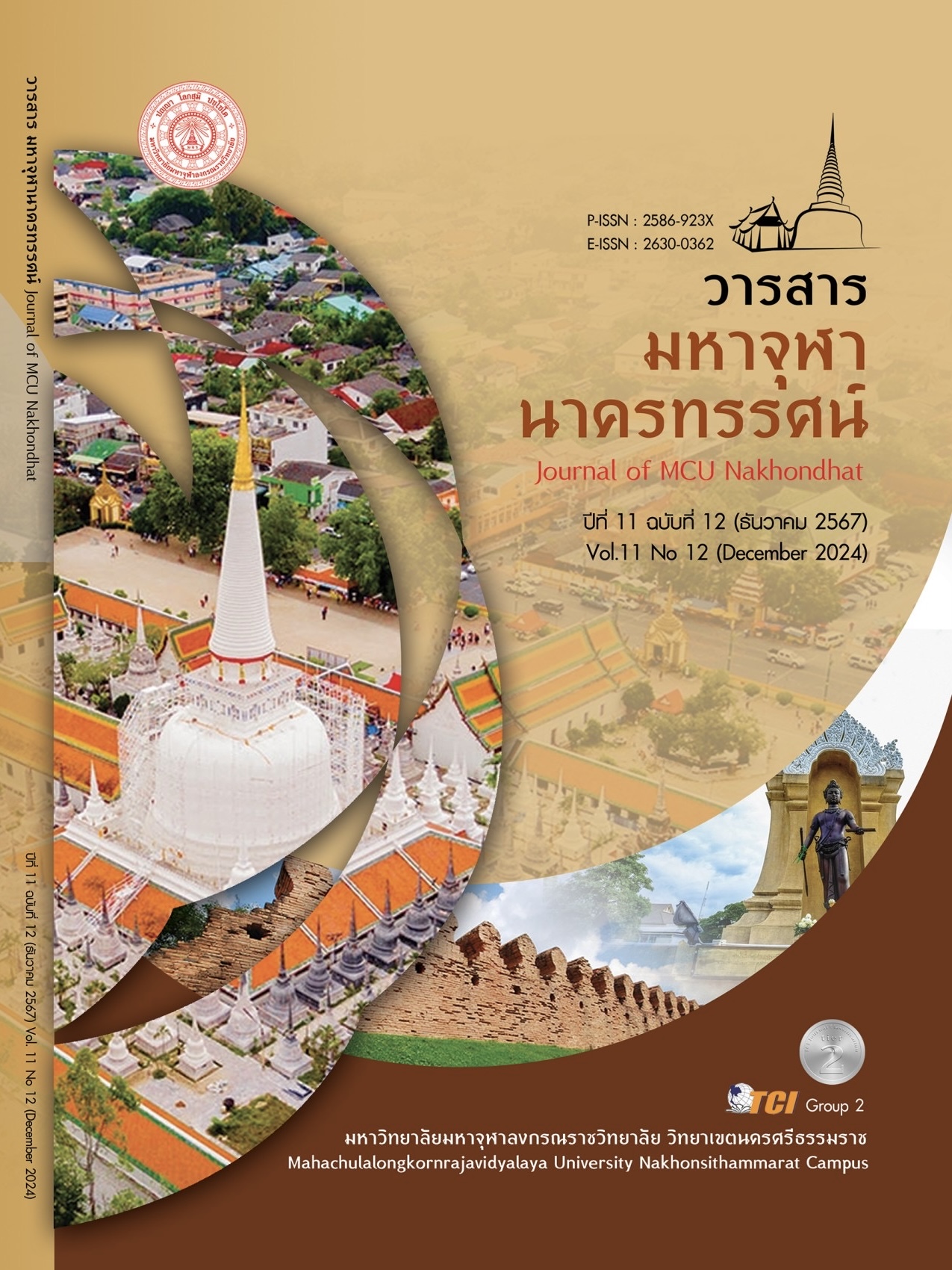THE ROLE OF WORLD TRADE ROUTES ACROSS THE SOUTHERN PENINSULA OF THAILAND AFFECTING BELIEFS: A CASE STUDY OF THE INFLUENCE OF BUDDHISM IN CHAIYA DISTRICT, SURAT THANI PROVINCE DURING THE 14-18
Main Article Content
Abstract
This article studies the role of global trade routes across the southern peninsula of Thailand and their impact on beliefs, specifically focusing on the influence of Buddhism in Chaiya District, Surat Thani Province during the 14th to 18th Buddhist centuries. It finds that the role and influence of trade routes affect religious beliefs in the Chaiya District during this period. Historically, the Chaiya area served as a vital link connecting two sides of maritime civilization that developed from early times to its peak, experiencing periods of decline and revival influenced by trade and political governance. Evidence shows human habitation from prehistoric times through the era of global maritime trade, with artifacts such as bowls, Buddha statues, ancient sites, and accounts from travelers reflecting continuous trade and exchange among people, utilizing connections between the Gulf of Thailand and the Andaman coast. These trade routes have played a crucial role in the spread and transformation of Buddhism in Chaiya District. This historical significance has inspired scholars recognized as important figures in global peace, such as Phra Buddhadasa Bhikkhu of Suan Mokkhapalaram, along with various unique traditions that have been passed down to the present, such as the processions of “Chak Phra” and the “Ten Month Festival” of the Southern people, among others. The information gathered from this study can be presented to further promote the global trade routes across the southern peninsula of Thailand as a World Heritage site of memory.
Article Details

This work is licensed under a Creative Commons Attribution-NonCommercial-NoDerivatives 4.0 International License.
References
ชวน เพชรแก้ว และสบาย ไสยรินทร์. (2544). สุราษฎร์ธานีของเรา. กรุงเทพมหานคร: กรุงสยามการพิมพ์.
ธรรมทาส พานิช. (2543). ประวัติศาสตร์ไทยสมัยศรีวิชัย. กรุงเทพมหานคร: สำนักพิมพ์ห้างหุ้นส่วนจำกัด เม็ดทรายพริ้นติ้ง.
นันทลักษณ์ คีรีมา. (2555). พระพุทธรูปสกุลช่างไชยา ระหว่างพุทธศตวรรษที่ 18-21. ใน วิทยานิพนธ์ศิลปศาสตร์มหาบัณฑิต สาขาวิชาประวัติศาสตร์ศิลปะคณะโบราณคด. มหาวิทยาลัยศิลปากร.
นภัคมน ทองเฝือ. (2564). ข้อมูลใหม่จากการขุดค้นโบราณคดี ณ เมืองโบราณไชยา อำเภอไชยา จังหวัดสุราษฎร์ธานี. กรุงเทพมหานคร: เรือนแก้วการพิมพ์.
ปรีชา นุ่นสุข. (2548). ประวัติศาสตร์พระพุทธศาสนาในคาบสมุทรภาคใต้ของประเทศไทย. ใน รายงานวิจัย. คณะกรรมการวิจัยการศึกษาการศาสนาและการวัฒนธรรมของกระทรวงศึกษาธิการ.
ปวินนา เพ็ชรล้วน. (2564). ข้อคิดเห็นเพิ่มเติมเกี่ยวกับประติมากรรมวฑุกะไภรวะ อำเภอเวียงสระ จังหวัดสุราษฎร์ธานี. วารสารวิชาการมนุษยศาสตร์และสังคมศาสตร์ มหาวิทยาลัยบูรพา, 29(2), 270-292.
พระประชา ปสนฺนธมฺโม. (2535). เล่าไว้เมื่อวัยสนธยา อัตชีวประวัติของท่านพุทธทาส. กรุงเทพมหานคร: มูลนิธิโกมลคีมทอง.
พระพรหมคุณาภรณ์ (ป.อ. ปยุตฺโต). (2555). พจนานุกรมพุทธศาสตร์ ฉบับประมวลธรรม. (พิมพ์ครั้งที่ 23). กรุงเทพมหานคร: มูลนิธิทำทานกุศลจิต.
พระมหาธงชัย วณฺณวีโร. (2561). การศึกษาพัฒนาการทางประวัติศาสตร์ของพระพุทธศาสนาในอำเภอไชยา จังหวัดสุราษฎร์ธานี. ใน วิทยานิพนธ์พุทธศาสตรมหาบัณฑิต สาขาวิชาพระพุทธศาสนา. มหาจุฬาลงกรณราชวิทยาลัย.
พระมหาสมปอง มุทิโต. (2547). คัมภีร์อภิธานวรรณนา. (พิมพ์ครั้งที่ 2). กรุงเทพมหานคร: ประยูรวงศ์พริ้นท์ติ้ง จำกัด.
มหาวิทยาลัยราชภัฏนครศรีธรรมราช. (2557). ปฐมบทพระพุทธศาสนาในภาคใต้ ประเทศไทย : หลักธรรมและหลักฐานโบราณคดี. นครศรีธรรมราช: ไทม์ พริ้นติ้ง จำกัด.
ศาสตราจารย์ หม่อมเจ้าสุภัทรดิศ ดิศกุล. (2560). ประวัติศาสตร์เอเชียอาคเนย์ถึง พ.ศ. 2000. (พิมพ์ครั้งที่ 6). กรุงเทพมหานคร: ห้างหุ้นส่วนจำกัด สามลดา.


